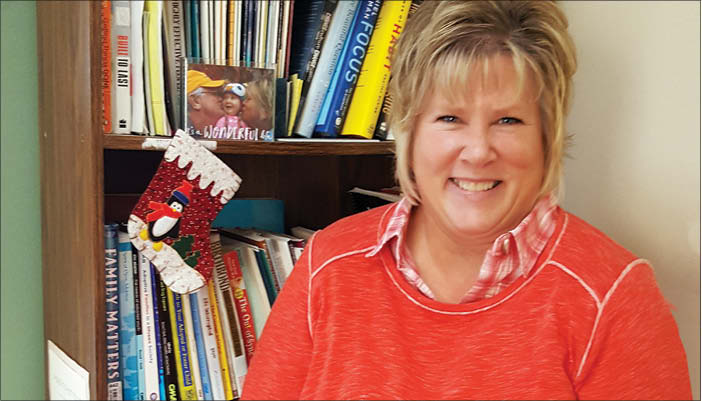The bookcase in Sue Grundysen’s office at The Village Family Services holds a shelf of classics unlike any other library in town.
“We call them ‘family books,’” says Sue, the director of the Adoption Option, a partnership of The Village and Lutheran Social Services. “Waiting families put them together to tell their stories … to make a connection with birth parents who are planning a home for their babies.”
Family books are a special kind of love letter to a child the couples yearn to meet. The one-of-a-kind hardcover books are partly photo albums of selfies, partly studies of the waiting family’s heart. Each contains dozens and dozens of photos –people, pets, pastimes– that paint a picture of the home that’s ready and waiting for a baby.
Most include verbal glimpses, too, of the couple’s hopes and values, as well as dreams for the life they hope to build with an infant they’ll be chosen to parent.
Under a headline, “Our Promise”: “We promise to bring up this child in a warm home filled with unconditional love and constant laughter – to nurture every ambition and allow them to become the person they were meant to be.”
“Adoption is entirely different than people remember it from back in the 1960s,” Sue says. She has worked with North Dakota infant adoptions for 30 years, the last 17 of them in LSSND and The Village’s collaborative program based in Fargo.
“An earlier generation saw it as something shameful,” she continues. “People used to talk about ‘giving up your baby’ and getting on with your life. I’ve got to tell you that in 30 years, I have never met one single birth mother who doesn’t have feelings and love for that child that last forever.
“Words are important. They used to say you ‘gave up’ or ‘kept your baby.’ Today we talk about ‘making a plan.’ It’s not just something you can do and forget. It’s a very active process of raising the child,” she explains. “We offer support to parents facing a situation they never expected. They’re working hard to put time, energy and a great deal of thought into what they’re about to do.”
Between 50 to 100 unexpectedly pregnant women seek out the Adoption Option each year at one of its four offices here and in Grand Forks, Bismarck and Minot. Though the stereotype might be a 15- or 16-year-old girl, most who come to the agency are actually in their 20s. “When a teen living at home finds out she’s pregnant, the family often finds a way to absorb that child,” Sue points out. “The women we see are at the point of establishing their own independent lives apart from their parents, and they recognize the challenges that lie ahead. For some, child-bearing just doesn’t fit.”
Over thecourse of their consultation, the majority – perhaps 80 percent — develop a strategy for parenting their children themselves. From eight to 12 infant adoptions are completed throughout the year. The agency also assists with identified adoptions, in which children are adopted by distant relatives, and the U.S. component of international adoptions.
“Fewer and fewer birth parents reach out to us for assistance and even consider adoption,” she reports. “That’s largely because there are very negative perceptions of what adoption is, based on the way it used to be. The young mother used to be sent away to deliver, then urged to forget about her child. When she got home, no one ever mentioned it again. It was shrouded all around in a culture of secrecy and denial. Yet the pain and all the questions never went away.
“In the adoption field, we’ve listened very carefully to adoptees and parents. We’ve done a lot of research to find what works best for everyone involved in the adoption triad, especially the children. Based on everything that we’ve learned over the years, we do it very differently now. Most importantly, we’ve learned to take care of the prospective adoptive family as well as the birth family – with the needs of the most vulnerable, the children, at the center.”
Communication is the key to the newer, healthier process of building adoptive families. “All of the domestic adoptions we do involve some degree of openness,” Sue says. The degree to which the new family relationships are open, however, is different in every case. “Openness involves a whole spectrum of conversations. It might mean sitting together in a room. It might be posting on Facebook, shooting a video, or even sending a snail mail letter with a stamp.”
It’s not defined as shared parenting. Instead, she says, it’s a process of all involved in the child’s life being honest with one another and treating each other with greater respect and compassion … all in the best interests of the child everyone loves.
“That child has a right to understand why he has brown hair and blue eyes, why she’s musically gifted but really terrible at sports, what health risks might affect him in years to come,” she explains. “When children ask, there had better be an answer there – a better one than ‘we don’t know.’”
Birth parents considering adoption are welcome to meet the potential prospects through the family books they prepare, either at the regional offices or online. Like ample details on the entire process of adoption, the family prospectuses are available online at thevillagefamily.org/adoption3. To qualify for the Adoption Option’s services, prospective adoptive parents must live in North Dakota. More information on adoption services available in Minnesota can be found at mnadopt.org, with the bulk of services headquartered in the Twin Cities.



